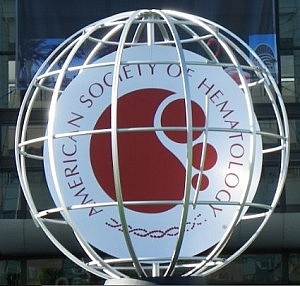ASH 2013 Myelofibrosis Preview
 This year, the 2013 annual meeting of the American Society of Hematology (ASH) in New Orleans is potentially the meeting of the year with much new data emerging, not only on a multitude of products, but also many biotechs – big and small – not just Pharma.
This year, the 2013 annual meeting of the American Society of Hematology (ASH) in New Orleans is potentially the meeting of the year with much new data emerging, not only on a multitude of products, but also many biotechs – big and small – not just Pharma.
Last week a chance event unexpectedly found me on the road for two days instead of feverishly browsing the ASH abstracts in real time for the first time in years. I’ve been attending the meeting since the mid 1990’s in various guises, so was quite sad not to be ‘present’ for moment they went live.
Nonetheless, I must pay tribute to the Twitter Bio community who merrily shared and discussed their favourite abstracts on various topics, which made finding and sorting relevant ones much easier and quicker than it might have been. In particular, Patrick Crutcher (@chasingthealpha) of Chimera Research Group did a sterling job of highlighting many key sessions on Twitter, despite being on the west coast for a 9am open time. If you’re not following him on Twitter, check him out!
While reading through all the links and notes I collated, it made sense to write a series of preview posts on different topics. This year, I will be writing five preview posts, with a different topic highlighted in each one:
- Myelofibrosis
- Multiple Myeloma
- Chronic Lymphocytic Leukemia (CLL)
- Acute Leukemias
- Lymphomas
For today’s review of Myelofibrosis, the following companies and compounds will be covered:
Companies: Incyte, Novartis, Gilead, Sanofi, BMS, Geron, CTIC, Lilly, Celgene
Compounds: ruxolitinib, INCB039110, momelotinib, fedratinib, BMS-91143, imetelstat, pacritinib, LY2784544, pomalidomide, sonidegib
Note that not all of these agents are JAK inhibitors – others have a different target and can potentially be used in combination with a JAK inhibitor, some are pan JAK inhibitors, some selective and others dual inhibitors. This previews are really mini reviews of the abstracts, meaning it may be easier to print them out and read or contemplate over a cup of coffee.
To learn more insights on this intriguing topic, subscribers can log-in or you can purchase access to BSB Premium Content.
This content is restricted to subscribers
5 Responses to “ASH 2013 Myelofibrosis Preview”
Imetelstat data are quite interesting, since it is showing some signs of clearing out the disease in the bone marrow, but as you said, small single-site study. Dr Tefferi also carries some baggage.
What is the ORR in this case? I dont believe they met the criteria(which Tefferi helped write) for actual CR or PR, since it has no mention of reduction in splenomegaly.
http://bloodjournal.hematologylibrary.org/content/108/5/1497/T1.expansion.html
“Overall response rate was 44%. This included five (28%) patients who met the BM and peripheral blood morphologic criteria for CR (n=4) or PR (n=1) and 3 patients with clinical improvement, pending validation of response duration and resolution of drug-induced grade-1 thrombocytopenia. The four (22%) CR patients experienced reversal of BM fibrosis and recovery of normal megakaryocyte morphology.”
Patrick, totally agree the data are interesting and also intriguing. However, it wasn’t clear from the abstract what the proposed mechanism of action is or what the overall effects are. As you point out, no mention was made of SVR – without that information I remain on the side of the sceptics here.
Dr Tefferi does indeed have some baggage as the prior brouhaha with the CYT387 anemia effect demonstrated at ASH in San Diego. That said, we should see some more data on that compound in New Orleans. Sometimes he is right, but for the wrong reasons!
Single institution studies are a pet peeve of mine. They are find for exploring an idea as a pilot to see if it’s worth pursuing in a phase I trial but there are a lot of caveats people should be aware of – investigator bias, lack of rigour, small N number etc to mention a few. Not all of these trials amount to much, maybe 9/10 go nowhere but occasionally one leads to something worthwhile. Whether this data is in the same league as Heikki Jonnsu’s GIST patient treated with imatinib is anyone’s guess at this stage!
Interesting that its effects on ET(89% CR) carried over to MF as well. I have heard Dr. Tefferi has also begun enrolling some MDS/AML patients, but have not confirmed it.
Imetelstat(GRN163L), is a 13-mer oligonucleotide, that inhibits telomerase directly by antagonistic binding with high affinity to the RNA template of telomerase (hTERC).
It will also be interesting to see what happens in PV, but I haven’t heard much on that front.
Imetelstat is indeed a 13-mer oligonucleotide but I’m going to reserve judgement on any efficacy effects until I see more data from several respected institutions. My issue with single centre studies always comes back to confirmation bias and whether a PI sees what he wants to see – or not.
I should add that it is possible that imetelstat exerts a specific effect in the bone marrow, thereby targeting the fibrosis without having an effect on the spleen. They could have very different mechanisms of action. If further large scale trials show this to be true, then it wouldn’t surprise me if a combination or sequencing approach might have legs. But that is a very big if until we get beyond a single institution trial, I would be inclined to be conservative and wonder if the results are an artifact until proven otherwise.
The upside though, will piqué a lot of interest!
Comments are closed.